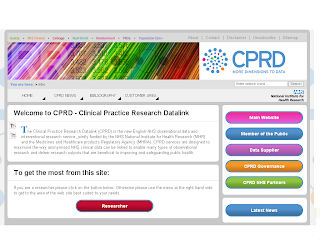For those of
you who enjoyed our reports on informatics platform development in the UK (use
the search feature on the blog to look for posts referencing 'NOCRI'), we're
going to be focusing again on enterprise platforms which support service
delivery and research with a global lens in the coming months. To whet your
appetite for upcoming posts here's a selection of projects we've come across in
the last week:
From HealthDataManagement.com: Truven
Health Analytics has introduced a new suite of products for statewide health
information exchanges, called HIE Advantage Analytics
The suite is
designed to enable public health officials to access and analyze operational
and clinical statistical data in a state’s HIE. The West Virginia Health
Information Network is an early adopter.
HIE Advantage
uses near real-time clinical data from providers, claims data from the Centers
for Medicare and Medicaid Services, and data from other sources that are stored
in state HIE repositories. The goal is to monitor community health status while
improving outcomes, according to Truven Health, previously the health care
business of Thomson Reuters.
Reports
analyze prevalence, process of care and outcome metrics for specific diseases,
as well as rates of screening and preventive care to identify communities at
higher risk for poor health status. More information is available here.
From Investors.com: The University of Texas
MD Anderson Cancer Center Selects Oracle Applications and Technology as Part of
Platform to Help Transform Cancer Care
·
MD Anderson, one of the world's most respected
centers devoted exclusively to cancer patient care, research, education and
prevention, has selected Oracle Health Sciences applications
and Oracle technology as the foundation for
an organization-wide analytics initiative designed to enable a new generation
of personalized cancer treatment that improves outcomes. The platform will also
support the center's renowned Moon Shots Program, an unprecedented effort to
dramatically accelerate the pace of converting scientific discoveries into
clinical advances that reduce cancer deaths.
·
Oracle applications and technology will power the
enterprise analytics initiative, one of the program's platforms. The new
platform will bring together clinical, genomic, financial, administrative and
operational information from internal and external sources to yield insights
that drive care innovation and optimize operational efficiency.
·
To achieve its goals, the center, ranked first for
cancer care in U.S. News & World Report's "Best
Hospitals" survey for seven of the last nine years, will deploy a wide range
of Oracle solutions, including Oracle Enterprise Healthcare Analytics and
Oracle Translational Research Center
·
MD Anderson, which sees data growth of 30 percent
to 40 percent annually, is also deploying Oracle Database and Oracle Business Intelligence Enterprise Edition.
From Executive Biz IBM to Provide Int’l
Medical Research Facility with IT Infrastructure, Application Support
IBM and the
Dmitry Rogachev Clinical Center have entered into a contract of agreement to
deploy PureFlex integrated systems in the Clinic’s facilities to bolster IT
support, according to an IBM statement.
“By 2015, we expect to increase the volume of
clinical tests five times and to be able to cover 5,000 primary patients
generating over a petabyte of medical data,” said Igor Pyatnitsa,
head of operations at the Russian Federal Scientific-Clinical Center of
Pediatric Hematology, Oncology and Immunology.
“This is valuable data which we must effectively
store and manage for medical and legal reasons. IBM’s PureFlex systems help us
to do this effectively while controlling costs and ensuring the highest levels
of data security,” he added.
The agreement is an extension of an existing
contract for the IBM PureSystems roll out.
The center focuses on finding treatment for blood
disorders, cancer, immune system diseases, and other diseases. It is a part of
the Russian Ministry of Health and a chief collaborator on more than 400
projects, 100 clinical trials and 20,000 medical tests per year.
This will be the first time PureFlex will be used
in Russia. PureFlex technology will assist the center with installing fast
systems and critical medical applications.
It will also help in organizing their extensive
medical data repository through an automatic locator using existing
applications. The hospital hopes that this will lead to better collaboration
and field research.
Andrey Filatov, Director, IBM Systems and
Technology Group for IBM in Russia and the CIS said the PureFlex Systems is
meant to provide a platform for Russian healthcare and medical research
development.
The offering is tuned for cloud computing and can
consolidate more than 100 databases on a single system and helps to rapidly
deploy medical applications.
Maryland-based information technology and
engineering provider Allied Technology Group has won a
five-year contract to help a U.S. Army medical research
facility in Silver Spring design, analyze and report on projects.
ATG says its statisticians and public
health analysts work with the Walter Reed Army Institute of Research ("the largest and most diverse biomedical research
laboratory in the Department of Defense") to include and
exclude criteria, select study subjects, develop analytic databases and analyze
statistics.
The company will provide the institute a team of
epidemiologists, biostatisticians and administrative personnel for analysis,
collecting and entering data, managing databases and programming computers.
Since 2007, ATG says staff members have authored and co-authored
articles for 30 peer-reviewed publications and 34 scientific presentations on
their work at the institute.


